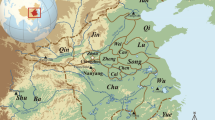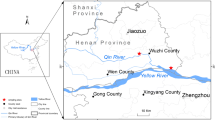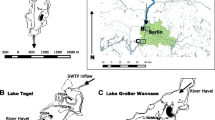Abstract
Principal component analysis (PCA) was performed on chemical data of two sediment cores from an urban freshwater lake in Copenhagen, Denmark. X-ray fluorescence (XRF) core scanning provided the underlying datasets on 13 variables (Si, K, Ca, Ti, Cr, Mn, Fe, Ni, Cu, Zn, Rb, Cd, and Pb). Principal component analysis helped to trace geochemical patterns and temporal trends in lake sedimentation. The PCA models explained more than 80 % of the original variation in the datasets using only two or three principal components. The first principal component (PC1) was mostly associated with geogenic elements (Si, K, Fe, Rb) and characterized the content of minerogenic material in the sediment. In the case of both cores, PC2 was a good descriptor emphasized as the contamination component. It showed strong linkages with heavy metals (Cu, Zn, Pb), disclosing changing heavy-metal contamination trends across different depths. The sediments featured a temporal association with contaminant dominance. Lead contamination was superseded by zinc within the compound pattern which was linked to changing contamination sources over time. Principal component analysis was useful to visualize and interpret geochemical XRF data while being a straightforward method to extract contamination patterns in the data associated with temporal elemental trends in lake sediments.








Similar content being viewed by others
References
Bhattacharya, P., Mukherjee, A. B., Jacks, G., & Nordqvist, S. (2002). Metal contamination at a wood preservation site: characterisation and experimental studies on remediation. Science of the Total Environment, 290, 165–180.
Borůvka, L., Oldřich, V., & Jehlička, J. (2005). Principal component analysis as a tool to indicate the origin of potentially toxic elements in soils. Geoderma, 128, 289–300.
Bro, R., & Smilde, A. K. (2014). Principle component analysis. Analytical Methods, 6, 2812–2831.
Bro, R., Acar, E., & Kolda, T. G. (2008). Resolving the sign ambiguity in the singular value decomposition. Journal of Chemometrics, 22, 135–140.
Chillrud, S. N., Bopp, R. F., Simpson, H. J., Ross, J. M., Shuster, E. L., Chaky, D. A., Walsh, D. C., Choy, C. C., Tolley, L.-R., & Yarme, A. (1999). Twentieth century atmospheric metal fluxes into Central Park Lake, New York City. Environmental Science and Technology, 33, 657–662.
Comero, S., Locoro, G., Free, G., Vaccaro, S., De Capitani, L., & Gawlik, B. M. (2011). Characterisation of Alpine lake sediments using multivariate statistical techniques. Chemometrics and Intelligent Laboratory Systems, 107, 24–30.
Council, E. (1975). Council directive 75/442/EEC of 15 July 1975 on waste. Official Journal of the European Communities, L194, 39.
Council, E. (1987). Council directive 87/416/EEC of 21 July 1987 amending directive 85/210/EEC on the approximation of the laws of the member states concerning the lead content of petrol. Official Journal of the European Communities, L225, 33.
Cox Analytical Systems .(2011). ITRAX corescanner—unique multi-function scanner for core examinations. http://coxsys.se/wp-content/uploads/2009/03/itrax-core-scanner4.pdf. Accessed 04 June 2014.
Croudace, I. W., Rindby, A., & Rothwell, R. G. (2006). ITRAX: description and evaluation of a new multi-function X-ray scanner. Geological Society, London, Special Publications, 267, 51–63.
Crutzen, P. J. (2002). Geology of mankind. Nature, 415, 23.
Danish Ministry of Climate, Energy and Building. (2013). Smart grid strategy—the intelligent energy system of the future. http://www.kebmin.dk//klima-energi-bygningspolitik/dansk-klima-energi-bygningspolitik/energiforsyning-effektivitet/smart. Accessed 09 May 2014.
Davison, W. (1993). Iron and manganese in lakes. Earth-Science Reviews, 34, 119–163.
Eisma, D., & Irion, G. (1988). Suspended matter and sediment transport. In W. Salomons, B. L. Bayne, E. K. Duursma, & U. Förstner (Eds.), Pollution of the North Sea—an assessment (pp. 20–35). Berlin: Springer.
Ellermann, T., Nøjgaard, J.K., Nordstrøm, C., Brandt, J., Christensen, J., Ketzel, M., & Jensen, S.S. (2012). The Danish air quality monitoring programme. Annual Summary for 2011. Scientific Report from DCE – Danish Centre for Environment and Energy, 37.
European Environment Agency (EEA) .(2014). Copenhagen beats Bristol and Frankfurt to win European Green Capital 2014. http://www.eea.europa.eu/highlights/copenhagen-beats-bristol-and-frankfurt. Accessed 22 April 2014.
Gredilla, A., Amigo, J. M., Fdez-Ortiz de Vallejuelo, S., de Diego, A., Bro, R., & Madariaga, J. M. (2012). Practical comparison of multivariate chemometric techniques for pattern recognition used in environmental monitoring. Analytical Methods, 4, 676–684.
Hallberg, R. O. (1991). Environmental implications of metal distribution in Baltic Sea sediments. Ambio, 20, 309–316.
Hansson, S. V., Rydberg, J., Kylander, M., Gallagher, K., & Bindler, R. (2013). Evaluating paleoproxies for peat decomposition and their relationship to peat geochemistry. The Holocene, 23, 1666–1671.
Haworth, E. Y., & Lund, J. W. G. (1984). Lake sediments and environmental history—studies in paleolimnology and paleoecology in honour of Winifred tutin. Minneapolis: University of Minnesota Press.
Kido, Y., Koshikawa, T., & Tada, R. (2006). Rapid and quantitative major element analysis method for wet fine-grained sediments using an XRF microscanner. Marine Geology, 229, 209–225.
Last, W. M., & Smol, J. P. (2004). Tracking environmental change using lake sediments—volume 1: basin analysis, coring, and chronological techniques. Dordrecht: Kluwer Academic Publishers.
Livingstone, D. A. (1955). A lightweight piston sampler for lake deposits. Ecology, 36, 137–139.
Löwenmark, L., Chen, H.-F., Yang, T.-N., Kylander, M., Yu, E.-F., Hsu, Y.-W., Lee, T.-Q., Song, S.-R., & Jarvis, S. (2011). Normalizing XRF-scanner data: a cautionary note on the interpretation of high-resolution records from organic-rich lakes. Journal of Asian Earth Sciences, 40, 1250–1256.
Lyons, W. B., & Harmon, R. S. (2012). Why urban geochemistry? Elements, 8, 417–422.
Matys Grygar, T., Sedláček, J., Bábek, O., Nováková, T., Strnad, L., & Mihaljevič, M. (2012). Regional contamination of Moravia (South-Eastern Czech Republic): temporal shift of Pb and Zn loading in fluvial sediments. Water, Air, and Soil Pollution, 223, 739–753.
Molin Christensen, J., & Holst, E. (1988). Evaluation of blood lead levels in Danes for the period 1976–1987. Fresenius’ Zeitschrift für Analytische Chemie, 332, 710–713.
Nicholson, F. A., Smith, S. R., Alloway, B. J., Carlton-Smith, C., & Chambers, B. J. (2003). An inventory of heavy metals inputs to agricultural soils in England and Wales. Science of the Total Environment, 311, 205–219.
Nriagu, J. O. (1979). Global inventory of natural and anthropogenic emissions of trace metals to the atmosphere. Nature, 279, 409–411.
Nriagu, J. O., & Pacyna, J. M. (1988). Quantitative assessment of worldwide contamination of air, water and soils by trace metals. Nature, 333, 134–139.
Olsen, J., Björck, S., Leng, M. J., Gudmundsdóttir, E. R., Odgaard, B. V., Lutz, C. M., Kendrick, C. P., Andersen, T. J., & Seidenkrantz, M.-S. (2010). Lacustrine evidence of Holocene environmental change from three Faroese lakes: a multiproxy XRF and stable isotope study. Quaternary Science Reviews, 29, 2764–2780.
Passos, E. A., Alves, J. C., dos Santos, I. S., Alves, J. D. P. H., Garcia, C. A. B., & Spinola Costa, A. C. (2010). Assessment of trace metals contamination in estuarine sediments using a sequential extraction technique and principle components analysis. Microchemical Journal, 96, 50–57.
Quinn, G. P., & Keough, M. J. (2013). Experimental design and data analysis for biologists. New York: Cambridge University Press.
Reid, M. K., & Spencer, K. L. (2009). Use of principle components analysis (PCA) on estuarine sediment datasets: the effect of data pre-treatment. Environmental Pollution, 157, 2275–2281.
Renberg, I. (1986). Concentration and annual accumulation values of heavy metals in lake sediments: their significance in studies of the history of heavy metal pollution. Hydrobiologia, 143, 379–385.
Selig, U., & Leipe, T. (2008). Stratigraphy of nutrients and metals in sediment profiles of two dimictic lakes in North-Eastern Germany. Environmental Geology, 55, 1099–1107.
Skaarup, B., Westerbeek Dahl, B., & Thorning Christensen, P. (1998). The fortifications of Copenhagen: a guide to 900 years of fortifications history. Copenhagen: National Forest and Nature Agency, Danish Ministry of the Environment and Energy.
Smol, J. P. (2008). Pollution of lakes and rivers—a paleoenvironmental perspective (2nd ed.). Malden: Blackwell Publishing.
Templ, M., Filzmoser, P., & Reimann, C. (2008). Cluster analysis applied to regional geochemical data: problems and possibilities. Applied Geochemistry, 23, 2198–2213.
Tjallingii, R., Röhl, U., Kölling, M., & Bickert, T. (2007) Influence of water content on X-ray fluorescence core-scanning measurements in soft marine sediments. Geochemistry, Geophysics, Geosystems, 8. doi:10.1029/2006GC001393.
Vasskog, K., Paasche, Ø., Nesje, A., Boyle, J. F., & Birks, H. J. B. (2012). A new approach for reconstructing glacier variability based on lake sediments recording input from more than one glacier. Quaternary Research, 77, 192–204.
von Storch, H., Costa-Cabral, M., Hagner, C., Feser, F., Pacyna, J., Pacyna, E., & Kolb, S. (2003). Four decades of gasoline lead emission and control policies in Europe: a retrospective assessment. Science of the Total Environment, 311, 151–176.
Walraven, N., van Os, B. J. H., Klaver, G. Th., Middelburg, J. J., & Davies, G. R. (2014). Reconstruction of historical atmospheric Pb using Dutch urban lake sediments: a Pb isotope study. Science of the Total Environment, 484, 185–195.
Weltje, G. J., & Tjallingii, R. (2008). Calibration of XRF core scanners for quantitative geochemical logging of sediment cores: theroy and application. Earth and Planetary Science Letters, 274, 423–438.
Wold, S., Esbensen, K., & Geladi, P. (1987). Principle component analysis. Chemometrics and Intelligent Laboratory Systems, 2, 37–52.
Zitko, V. (1994). Principle components analysis in the evaluation of environmental data. Marine Pollution Bulletin, 28, 718–722.
Zupan, M., Einax, J. W., Kraft, J., Lobnik, F., & Hudnik, V. (2000). Chemometric characterization of soil and plant pollution: part 1: multivariate data analysis and geostatistical determination of relationship and spatial structure of inorganic contaminants in soil. Environmental Science and Pollution Research, 7, 89–96.
Acknowledgments
We hereby thank Barbara Wohlfarth, Malin Kylander, and Ludvig Löwenmark for supporting and assisting XRF core scanning at the Department of Geological Science, Stockholm University, Stockholm, Sweden. The comments and suggestions of an anonymous reviewer were greatly appreciated.
The project is financed by Geocenter Denmark.
Conflict of Interest
No conflict of interest exists for any of the authors.
Author information
Authors and Affiliations
Corresponding author
Rights and permissions
About this article
Cite this article
Schreiber, N., Garcia, E., Kroon, A. et al. Pattern Recognition on X-ray Fluorescence Records from Copenhagen Lake Sediments Using Principal Component Analysis. Water Air Soil Pollut 225, 2221 (2014). https://doi.org/10.1007/s11270-014-2221-5
Received:
Accepted:
Published:
DOI: https://doi.org/10.1007/s11270-014-2221-5




